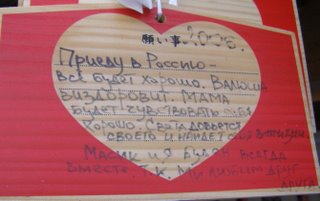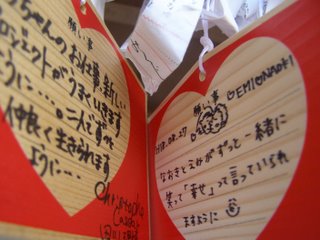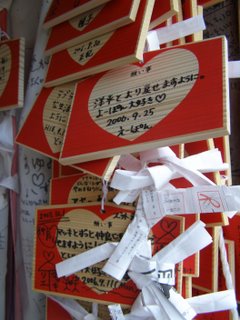THE LOVE SHRINE
The validity of premonition. The verity of signs. What is coincidence and what is fate? Whether it is in a hammock, scented bath, early mornings hidden under the covers, long car rides by myself, or sprawled out on my chaise lounge with my feet in the air, these are topics I have given considerable time. It’s always been frustrating to me as someone who works in metaphors and analogies to desperately need explanations.
Rituals bring comfort. What makes someone who has OCD and needs to touch a light switch 32 times so they won’t explode any different from someone who has to say the rosary three times a day so they won’t burn in hell. Are all rituals a false protection like a stuffed animal you tuck under a child’s arm at night so they won’t have bad dreams? Do we replace these stuffed animals with more acceptable but equally useless versions of security? Is it worth it if it eases our mind? One of the fascinating things I find about other cultures are their rituals and customs. It’s a glimpse into what alleviates their pain or brings them hope. It even displays how they punish themselves. We all have some form of “Hari-Kari,” be it through drink, or reckless behavior or even parasitic relationships. But how do people submerged in their routines keep their faith when things go awry. Do they keep their heads bent and minds true, or do they seek out signs as guidelines to show them that they are on the right path?
I have been trying to decipher if I am only reading signs just because I am striving for a connection. I can’t disconnect the oddities or the happenstances that often make me pause and reflect, but maybe a pause is all it is worth. When it comes down to it, perhaps I am clueless in my interpretation. I don’t know which is more enigmatical, that you read someone incorrectly and didn’t use proper judgment, or this individual is not who you thought. The pain of being wrong, or the pain of losing faith in someone - neither is a happy solution.
Just yesterday, my friend Colleen handed me a quote from the Dalai Lama “We also often add to our pain and suffering by being overly sensitive, over-reacting to minor things, and sometimes taking things too personally.” It was completely relevant to my current state of mind. That same morning, I got more Dalai Lama quotes emailed to me from an unusual source. For the record, I don’t usually have people giving me advice from his Holiness.
Last week, when I was finishing my blog about Maya Angelou, I received an email from a old friend, who I had not heard from in years (and have never received an email from) with a list of Maya Angelou quotes. There was no greeting, no update, just quotes. Both of these are pleasant synchronisms, but do they mean anything? What are the degrees of importance when it comes to judging signs?
Recently, I have been deliberating the value of signs. Am I putting significance on something that doesn’t need to be? Am I holding onto someone that needs to be let go because of some list of odd events and coincidences that triggered a strong emotion in me, but in reality means nothing? When does effort become wasted energy? Do I go against actions for instinct? How long can I keep the faith before it is just plain stupidity on my part. So, after the burning on Chirihama Beach, I settled into the back of the car as we headed to the Love Shrine.
The Keta Taisha is a Shinto (the way of the gods) temple in Hakui City in Teramachi. It’s located on the sacred forest on the Noto Peninsula and has been a place of worship for over 2,000 years. Shinto is the indigenous faith of the Japanese people. It’s characterized by revering nature and ancestral spirits without a formal dogma. Shinto, influenced by Buddhism and Confuciusism, does not believe there are absolute rights or wrongs. Nobody is perfect, but they believe humans are fundamentally good. They deem that evil is caused by evil sprits so the meaning of many of their rituals is to keep evil spirits at bay.
Okuninushi-no-mikoto, the god of marriage lives at the Keta Taisha Shrine. One of the reasons it has grown in popularity as a “love temple” is that one of the Royal Family prayed at the shrine and became engaged shortly after. Now, people come from all over to write down their wishes, desires or blessings on an ema (wooden plaque) and leave them at the shrine for the kami (spirits or gods) so they can read them.



After cleansing myself at the purification fountain, I wrote my prayer on my ema and looked for the ideal place to hang it for the kami to read it. I saw a tree and hung it on the back branch away from the others but still in the sun. The tree was lush and incredibly green. Later, I discovered that it was a 1,000-year-old holy tree.


MY EMA
While my friends Neil and Colleen wrote a blessing for Chris and Yuki’s wedding, I wandered the grounds. Immediately, I was struck by kinship of the forest and the human soul -. ancient trees surrounded by ancient desires. People’s wants and hopes were just as old as the trees they hung them on. There is comfort in that. Nature and matters of the heart are sacred and need to be protected.
Standing under the Torii gate (gate of the gods) an older Japanese man in a long white robe approached me. His graying hair was combed back and he wore large glasses. He had a smooth, open face that was perfected with a childlike enthusiasm, but coupled with that rare grace of patience and sagacity. It was a quality I immediately found endearing; he reminded me of the tree I had just hung my ema on – youthful and wise. Regardless of this initial impression, my instant Western reaction was that he was trying to sell me something and I kept motioning that I was okay by myself. He wasn’t trying to get anything from me; he was trying to give. He was the head priest of the shrine – Hideo Mitsui. Despite my polite declines for company or assistance, he seemed anxious to talk to me and continued engaging me. At one point he asked, “What do you do?” Not wanting to go into lengthy detail or long explanations I just replied, “I write.” He smiled and didn’t ask me any more. His English was fairly good and when Colleen and Neil came over, he insisted on taking us on a private tour. With their assurances, I followed along.

One of the first things he told us (and he repeated this no less than ten times) was that when Emperor Hirohito came to the shrine 23 years ago, he was his personal guide. There were pictures of the emperor’s visit all over the shrine. One of Mitsui-san’s favorite phrases was “Very famous. Very famous in the whole world.” Mitsui-san was also the personal guide to many members of the royal family. He was no longer a guide so to receive a private tour was a great honor.
Mitsui-san spoke to us about Shinto and the history of the temple, then showed us the entrance to the woods. No one, not even him, was allowed in the virgin forest. It was holy ground; he was only the guardian. Afterward, he helped me pick out a special charm for protection. The tour ended. Thrilled by this special treatment, we thanked him profusely and then Colleen and I went to find a bathroom. When we came back, Mitsui-san was waiting for us. Asking us to follow him, he lead us to his personal quarters where other visitors weren't allowed.
Earlier that day, I mentioned to Colleen that I would like to get some calligraphy IF I found something that spoke to me. When Mitsui-san took us to his private dwelling, it became apparent that he was going to make personal calligraphy for Colleen and me. There was no hesitation as he dipped his brush into the pot of ink. His slight movements of hand became fluid forms on the paper. I had never seen anyone's hands dance with ink before. I didn’t know if I was more honored that I was allowed to watch him do his art or that he was making a blessing for me. When he handed my gift over, he gave me a smile, a nod and said, “Your dreams will come true.” The official translation of my calligraphy means, “The majesty of God shines on your path.” Colleen’s translation meant, “The Core Belief” which is the foundation of bushido (the way of the samurai). She is the strongest warrior.


After Mitsui-san gave us our calligraphy, he led us to his bedroom to show us where Hirohito rested when he visited. The room was simple with another picture of the emperor to which he pointed. “Very famous. Very famous in the whole world.” It hung next to a scroll he recently completed – Happiness & Love.

Mitsui-san walked us to the car. On the way he told me he learned a lot of his English from American Movies. I was curious what kind of movies a Shinto Priest would enjoy but he couldn’t give me any specifics. I wanted to at least know where he got his charming way of responding, “Well, then, let’s see…” to my questions.
I thanked him again and as we were saying goodbye, Mitsui-san clasped my hands, smiled and said, “Nobel Prize in Literature.” Then we waved our goodbyes.
So there you go…. Maybe it was a sign. Maybe it wasn’t. I am still feeling a little off and unsure of my instinct. Maybe the trip to the love shrine for me was to reaffirm what I love to do, not who I love. Maybe that will be enough, or maybe that will be all. I don't know. Ideally, both would be nice.
What I do know is, regardless of my future, I will always looks back on it as a lovely afternoon with an even lovelier man.
Thank you, Mitsui-san.

Some Wisdom of the Dalai Lama
1. Take into account that great love and great achievements involve great risk.
2. When you lose, don’t lose the lesson.
3. Follow the three R’s a) Respect for self, b) Respect for others, c) responsibility for all your actions.
4. Remember that not getting what you want is sometimes a wonderful stroke of luck.
5. Learn the rules so you know how to break them.
6. Don’t let a little dispute injure a great relationship.
7. In disagreements with loved ones, deal only with the current situation. Don’t bring up the past.
8. Once a year, go someplace you’ve never been before.
9. Approach love and cooking with reckless abandon.
10. Remember that the best relationship is one in which your love for each other exceeds your need for each other.


0 Comments:
Post a Comment